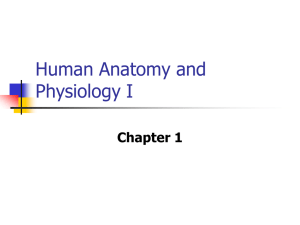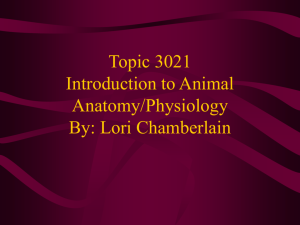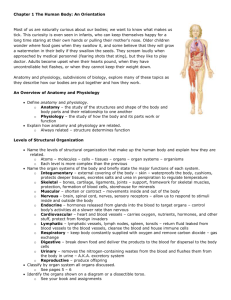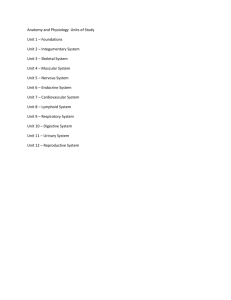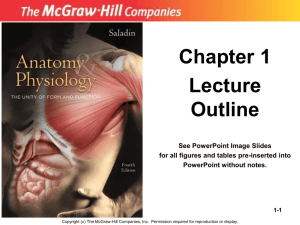Human Anatomy and Physiology I
advertisement
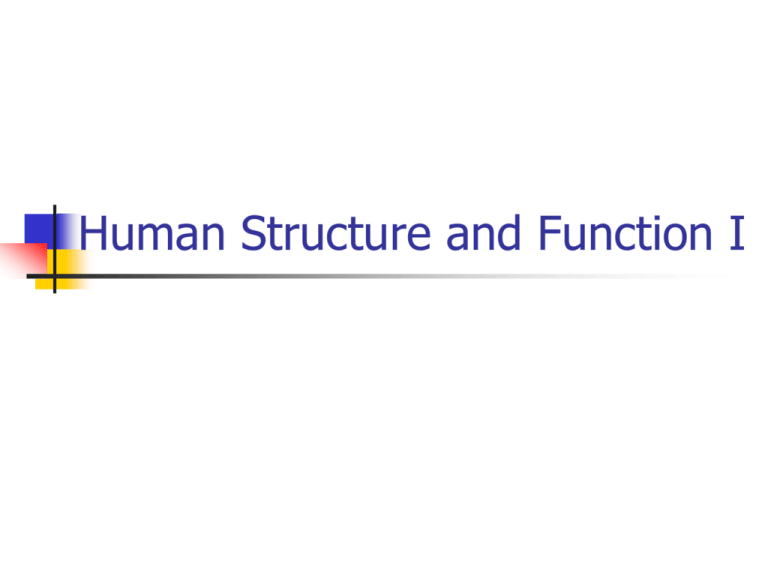
Human Structure and Function I Dr. Diane M. Gilmore LSE 415 Phone: 680-8083 mgilmore@astate.edu www.clt.astate.edu/mgilmore Office hours: Monday and Wednesday 3 -5 p.m. Thursday 2:30 p.m. – 3:30 p.m. And by appointment Textbook Medical Physiology 2nd or 3rd edition Rodney A. Rhodes, Lippincott Williams and Wilkins Laboratory Manual - Human Anatomy and Physiology 8th or 9th Cat edition with PhysioEx by Marieb Course Objectives: Foundation Medical terminology Metabolism Organization of the body Cell structure Tissues Integumentary, Skeletal, Muscular and Nervous Systems Classroom Etiquette: Turn off pagers and cell phones especially during exams! No tobacco use of any kind Be considerate of others: Take out what you bring in. Talk to me, NOT your neighbor! Do not ask for grades over the phone or internet. Academic Integrity Use Professional ethics NO: Plagiarism Cheating Allowing others to copy from you Penalties can be severe !! Attendance is important ! All material covered in class is fair game for exams! Other: Inclement weather Disability services Make ups Schedule – read your syllabus !!! Exams : 4 exams worth 100 points Multiple choice, diagrams, fill-in and essay questions Comprehensive final Exam A = 450 – 50 points B = 400 – 449 points C = 350 – 399 points D = 300 – 349 points F less than 300 points • Organization of the body and how it functions • Begin to understand the complexities of the human body and see how all body systems work together • Biochemistry, cells, tissues, and the integumentary, skeletal, muscular and nervous systems. You will learn a new language, made up of reusable and interchangeable parts. Gluconeogenesis Gluco – sugar - glucose Neo - new Genesis - to make, produce or generate The production of new glucose molecules from other, non-sugar, substances. Glucosuria Gluco – sugar (glucose) Uria - urine An abnormal amount of sugar in the urine Hematuria Uria - urine Hemato - blood Blood in the urine Hematoma means: A) To produce excess urine B) A clotting disorder where the patient continues to bleed C) A swelling caused by the growth of new cells D) A swelling caused by blood Anatomy is the study of the STRUCTURES of the body, and the relationship among structures. This is the WHAT and WHERE of the body. The word itself means “to cut up.” Types of anatomy • Gross anatomy – Regional anatomy – Systemic anatomy – Surface, developmental, clinical and surgical anatomy • Microscopic anatomy – Cytology – histology Physiology is the study of how the body Functions. The “how” is often on a chemical level. Anatomy and Physiology are closely integrated, both theoretically and practically All specific functions are performed by specific structures. organism organ system organs tissues cells – smallest living thing organelles molecules Atoms (elements) Homeostasis is maintaining a fairly constant internal environment in spite of a changing external environment. All body systems attempt to maintain homeostasis. What can upset homeostasis? Feedback loops: 1. Control center 2. Receptors that monitor changes 3. Effectors receive information from the control center and produce a response Negative feedback reverses changes Positive feedback brings a process to completion Disease is a homeostatic imbalance. Symptoms are subjective changes that are not apparent to an observer. Signs are objective changes which can be observed or measured. • We can divide the body into two portions: – Axial portion – Appendicular portion Thoracic and abdominopelvic membranes: Visceral (guts) refers to the membrane closest to the organs. Parietal refers to the membrane that lines the body walls. The pleura surround the lungs The pericardium surrounds the heart The peritoneum surrounds the abdominal organs Directional Terms: Superior (cephalic or cranial) – toward the head, upper, or above. Inferior (caudal) – toward the feet, under or below Anterior (ventral) – front, or in front of Posterior (dorsal) – back or in back of Medial (mesial) – toward the midline of the body Lateral – toward the side of the body or away from the midline Intermediate – between two structures Ipsilateral – on the same side of the body Contralateral – on the opposite side of the body Proximal – toward the trunk of the body or the point of origin of a body part. Distal – away from the trunk of the body or the point of origin of a body part. Superficial – toward the surface of the body Deep – away from the body surface Body Planes and Sections • Imaginary flat surfaces that divide the body or organs




